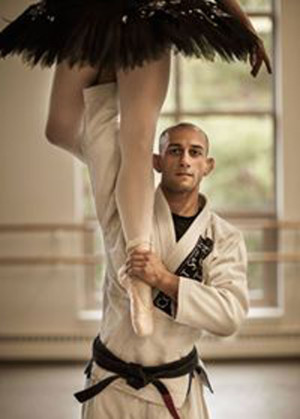
When Russian choreographer George Birkadze literally sweeps a girl off her feet, she floats overhead like a cloud. It’s like making a shoulder press with a 110 lb-barbell seem like a light and airy dance.
The strength comes from his martial arts training, while the seamless quality has been cultivated by ballet.
Birkadze, Boston Ballet’s ballet master, has been working on Ballet Philippines’ (BP) new production of “Firebird,” based on the classic score by Russian composer Igor Stravinsky.
BP president Margie Moran-Floirendo and artistic director Paul Morales broached the idea of a Filipino-themed ballet, so Birkadze drew similarities between Russian folkloric creature and the Sarimanok, our local mystical bird.
Birkadze’s interpretation of the Firebird is not some feathered creature who saves the day as portrayed in other ballets, but as symbol of power, renewal and sensuality.
“I’ll say this much, the Firebird and the Princess like the Prince, and he likes them both,” says the guest choreographer.
Spontaneity
Coming from a family of actors, he imbues his choreography with spontaneous and nuanced acting—“unless it’s abstract dancing, movement without meaning or expression as gymnastics,” he says. “I always tell the dancers that you don’t play the role, but be it.”

of classical partnering. His upper body strength in this one-arm lift is the result of martial arts training.
Birkadze hasn’t only been sharing acting and partnering techniques to dancers. Upon arriving in Manila, he watched the national wrestling team’s practice at Rizal Memorial Coliseum.
He impressed the team with his credentials. Outside the dance studio, he’s a faculty member of Boston Brazilian Jiu-Jitsu, the top training center in New England. His martial arts resumé includes being a former member of the Special Forces Division of the Soviet Army, a black belt in karate, brown belt in Brazilian jiujitsu, and a mixed martial arts coach in America.
He has nothing but praise for Filipino athletes: “They’re warm and friendly, but they fight like gorillas. The greatest show of strength is to be quiet about your power.”
Counterattack
Birkadze recalls that he was as fascinated with martial arts as he was with ballet. Growing up in the former Soviet republic of Georgia, he was often bullied by schoolmates for taking up ballet.
“Every Friday, the bullies would destroy my books, pull my collar, tear off my clothes and spit on me,” he recounts. Instead of being traumatized, he defended himself.
One day, three boys ganged up on him while the leader burned Birkadze’s neck with a hot wire. “I fought as if I were in training,” he recalls. Birkadze made a counterattack with jabs and kicks. As a coup de grâce, he threw two opponents on the floor. Meanwhile, the leader froze in shock.
But the bullying didn’t end there. While studying at Bolshoi Ballet Academy in Moscow, Birkadze would be taunted for being one of the few boys in classes and for not speaking with a Russian accent.
One time, while escorting his classmates on the streets, bullies started to jeer at the group. Birkadze remained calm and glared at them: “I was ready to fight. Because I didn’t react, they left us alone.”
In Europe, where he performed for Jeune Ballet de Catalonia, National Ballet of Portugal and Corella Ballet, his skills came in handy.
“I tried to stop three guys from fighting in a discotheque. They were throwing things all over the place,” he says. The trio were all overpowered by Birkadze.
Top shape
In 2010 he moved to America, choreographing for several companies. In 2014, he recreated his dances for BP. Although he no longer performs, he keeps in top shape with his martial arts regimen.
His daily routine consists of supersets or nonstop execution of two exercises, mostly using both bodyweight and weight resistance. Instead of focusing on a specific muscle group, he prefers overall body conditioning.
He compares his workout to a dance class which runs the gamut from the plié or bending of the knees to make the joints and muscles elastic, to the climactic big jumps.

When he coaches dancers, he treats them like professional fighters. “I always say that all dancers are fighters and all fighters are dancers,” says Birkdaze.
To strengthen dancers, he works out on their weak spots such as the obliques. These are the side muscles on the core that stabilize the spine and allow the torso to bend and twist. Since ballet uses more hip and leg work, the upper body tends to be weaker.
Core training
Birkadze complements the ballet training with shoulder conditioning. He is careful, though, not to overdevelop the deltoids and the pectorals that cause rounded shoulders.
His workouts include extensive core training to prepare dancers for the leaps. “The advantage of martial arts is that there’s a lot of explosive jumps,” he says.
Although martial arts seem more exciting and dangerous to watch, Birkadze says ballet is more difficult. The dancer is forced to use the body in the most unnatural way, such as the turnout or rotation from the hips. The misalignment often leads to serious injuries.
He says that when a martial arts practitioner hits 30, he’ll complain about a shoulder pain. But at that age, many professional dancers have experienced being sidelined by an average of five injuries. Still, dancers go on because dance provide creative expression.
Boyish-looking at 40, Birkdaze is in his top form as a martial artist. For him, age is all in the mind.
“You can be over 40, eat, watch TV and get fat or eat, drink and burn calories. Never tell yourself that you’re too old to exercise.”
“Firebird and Other Ballets” goes onstage Aug. 19-21 at Cultural Center of the Philippines Main Theater. Also featured are “Neneledej” by Spanish choreographer David Campos, Dwight Rodrigazo’s “Moving Two,” and Carlo Pacis’ award-winning “Shifting Wait.” Call 5511003, e-mail [email protected], or visit facebook.com/balletphilippines.








































